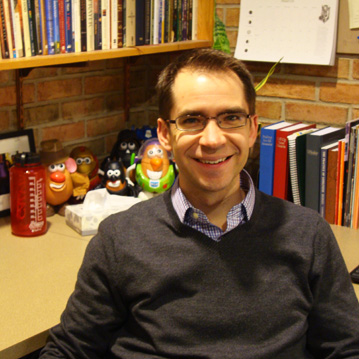Paul S. Ryan and Luke Enders on the Calvin 50 Song Collection
What we sing in worship shapes our vision of who God is and what God cares about. One college chose a list of 50 worship songs to help its students sustain a life of faith.
 |
 |
Paul S. Ryan is the associate chaplain for worship at Calvin College in Grand Rapids, Michigan. Luke Enders, a Calvin College junior, is a former campus worship apprentice and serves as praise team leader at Second Christian Reformed Church in Grand Haven, Michigan. In this edited conversation, Ryan and Enders talk about curating a collection of 50 songs for balanced and inclusive worship in college dorms.
Can you briefly describe your Calvin 50 song collection project?
PR: Each Calvin College dorm has a Barnabas team that helps plan weekly dorm worship. Matt Postma, the associate chaplain for residence life, and I wanted to create a resource that would help Barnabas teams create balanced and inclusive worship—reflected both in the gathered people and the emotions we bring into worship. Matt created a simple planning template for dorm worship, so students would have a consistent experience across dorms. We hired Luke Enders to come up with a list of 50 recommended songs for Calvin 50.
LE: Calvin 50 is a pdf document. The whole thing is like a mix of the Lift Up Your Heart hymnal and The Worship Sourcebook—but in a much more manageable size. We tried to choose songs for each liturgical season and each worship category, like gathering and praise, confession and assurance, illumination and guidance, faith and prayer, and service and sending.
How did you start choosing songs for Calvin 50?
LE: We started with lists of all songs sung in daily chapel services and Sunday LOFT services from the last four academic years. Over four years, this amounts to 350+ songs. All these songs are either in the public domain or are covered by our CCLI or OneLicense and therefore for use only on campus. I selected 100 songs from what we know we’ll keep singing, and I also added some newer songs that we think should be in students’ song diet.
What do you mean by the phrase “song diet”?
PR: Songs sung three or four times become formative, so we need to pay attention to how what we sing in worship is forming our faith and life. We want campus worship music to express community in our school and to shape our community to receive the gifts of the church of all times and places.
Keeping track of what we sing helps us plan worship that represents different moments and seasons of the Christian year and the fullness of the liturgy, such as praise, confession, and dedication. It helps us measure whether we’re singing enough gospel or liturgical folksongs or songs in Spanish and so on.
How do you keep track?
LE: Paul has an Excel spreadsheet that lists song title; worship function, such as confession or dedication; and musical genre, such as liturgical folk, classical hymnody and psalmody, gospel and spirituals, global, and praise and worship. He also has columns for four school years, so we can see how many times a song was sung each school year and in what venue, such as chapel, LOFT, or a special service.
PR: Worship apprentices (WAs) have responsibility to chart the songs they use. Each month the WAs and I review to see where we are out of balance for song health. Sometimes we’re weak in songs of confession, because we more often pray confession than sing it. Sometimes we are weak in songs of dedication, sacrifice, and justice. That’s primarily because Pastor Mary usually ends her sermons in grace, which doesn’t always segue well with a sending song about justice.
It sounds like each song chosen for Calvin 50 had to do a lot…
LE: Yes, so, for example, I included “Prayers of the People” by The Brilliance, because it’s a newer song that you can use to intersperse prayers and music. From living in the dorms, I knew that a dorm worship team might not have many musicians, maybe just one person on guitar or a keyboardist and percussionist. That meant I had to choose songs that were simple to play. If a song needs a whole rhythm section to sound right, I didn’t include it. Paul and Matt looked at my list of 100 and recommended up or down, but the final choice was mine. Each song I deleted was like a piece of my heart.
PR: Luke did a lot of work to write out lead lines and charts for songs we just had chords for. He worked hard to make lead sheets very simple.
Does the Calvin 50 have relevance beyond weekly dorm worship?
PR: Dorms began using Calvin 50 in September 2017. Our goal in chapel and LOFT services is to use every Calvin 50 song during the school year, as a touchstone to dorm worship. We have a new WA team each school year, and we hope Calvin 50 will help make sure that beloved songs from a previous WA team will influence new WAs. Each year I ask incoming WAs to mark songs that they don’t know. Some have only ever sung praise and worship songs, never hymns or any other genre. Identifying unfamiliar songs from our repertoire helps us know which songs will require more teaching.
How long will Calvin 50 remain relevant?
PR: I’d expect that a main core of 75 to 80 percent of songs would continue from year to year. We might make some changes every year or two, like maybe a song doesn’t take off like we thought it might, but maybe there’s a new Wendell Kimbrough song that could replace it. Making changes will be easy because Calvin 50 is a pdf document. It might be a good idea for future Barnabas teams to keep records of which Calvin 50 songs get sung in dorm worship.
Where can people get a copy of Calvin 50?
PR: Because CCLI and OneLicense allow us to use the songs only on campus, we can’t share the pdf. However, you can see the list of songs here. For schools that want to curate their own list of 50 songs, I recommend they first start tracking songs to see where they are out of balance.
LEARN MORE
Paul Ryan says that many churches use Planning Center Online software to plan worship and track songs.